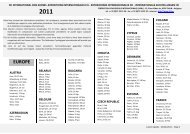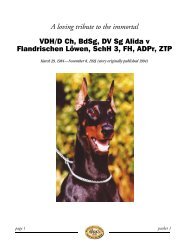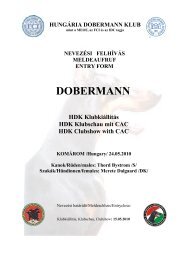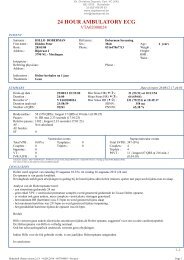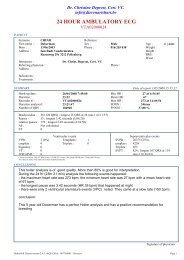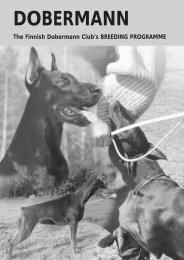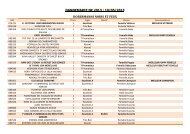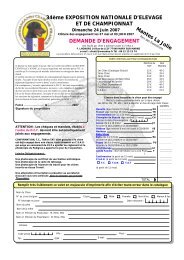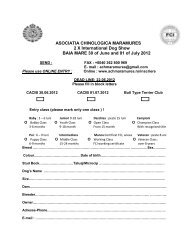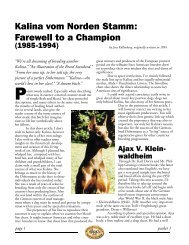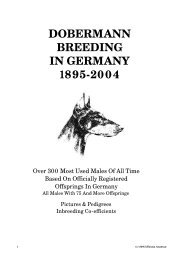Increasing Hereditary Health Problems in the Breeding of Purebred ...
Increasing Hereditary Health Problems in the Breeding of Purebred ...
Increasing Hereditary Health Problems in the Breeding of Purebred ...
- No tags were found...
Create successful ePaper yourself
Turn your PDF publications into a flip-book with our unique Google optimized e-Paper software.
The vWD gene frequency <strong>in</strong> <strong>the</strong> American Doberman populationis very high: approximately 30% are homozygote affected,50% are carriers (heterozygote vWD, leav<strong>in</strong>g only 20% <strong>of</strong>dogs completely clear <strong>in</strong> phenotype and homozygote free <strong>of</strong>vWD genes <strong>in</strong> genotype (Kurz 2004). Probably <strong>the</strong> EuropeanDoberman is still only lightly burdened with vWD genes at <strong>the</strong>moment but exact figures do not exist. Fur<strong>the</strong>r <strong>in</strong>crease can beexpected also <strong>in</strong> <strong>the</strong> European Doberman because <strong>the</strong> breedershave taken only limited actions towards limit<strong>in</strong>g <strong>the</strong> damage.The extensive North American experience could be helpful<strong>in</strong> Europe. The vWD is found <strong>in</strong> 57 o<strong>the</strong>r breeds <strong>of</strong> purebreddogs: German shepherd dog, Corgi, Sheltie, Golden Retriever,Manchester terrier, poodles and many o<strong>the</strong>r breeds (Willis 1992,Schueler 1997), but <strong>the</strong> gene frequencies are lower than <strong>in</strong> <strong>the</strong>Doberman. For several o<strong>the</strong>r breeds, <strong>the</strong> homozygote-affecteddogs are subject to potentially lethal episodes <strong>of</strong> external and<strong>in</strong>ternal bleed<strong>in</strong>g that can occur any time and must be treated bya veter<strong>in</strong>arian. But fortunately homozygote Doberman bleederscan still produce a small amount (5-10%) <strong>of</strong> normal factor (Kurz2004) provid<strong>in</strong>g some protection aga<strong>in</strong>st uncontrolled bleed<strong>in</strong>gand mak<strong>in</strong>g <strong>the</strong> disease milder for affected Dobermans.The symptoms (phenotypes) shown by affected and carrierDobermans have such great variability because <strong>the</strong> actual vWFlevels <strong>in</strong> both affected and carrier can vary widely <strong>in</strong> differentdogs and also <strong>in</strong> <strong>the</strong> same dog at various times <strong>in</strong> his life. Thesegreat phenotypical variations must arise from <strong>in</strong>teractions <strong>of</strong> <strong>the</strong>vWD gene with o<strong>the</strong>r (unknown) genes and to environmentalfactors <strong>in</strong> <strong>the</strong> <strong>in</strong>dividual Doberman (stress, high <strong>in</strong>breed<strong>in</strong>g,hypothyroidism, o<strong>the</strong>r diseases or factors). There is also <strong>the</strong>possibility that we have more than one deleterious mutation <strong>in</strong><strong>the</strong> vW genes or different alleles at <strong>the</strong> same gene locus, sothat <strong>the</strong> prote<strong>in</strong>s <strong>in</strong> phenotypes <strong>of</strong> different affected and carrierDobermans are different. Research is cont<strong>in</strong>u<strong>in</strong>g (CornellVeter<strong>in</strong>ary School).In genotype, both carriers and affected dogs differ only <strong>in</strong> <strong>the</strong>degree <strong>of</strong> penetrance <strong>of</strong> <strong>the</strong> defective gene (Dodds 1988).That is, a carrier although outwardly a healthy Doberman is notvigorous, <strong>in</strong> <strong>the</strong> sense that it does not have <strong>the</strong> same reservesas a normal dog to withstand environmental stress. If a vWDcarrier becomes hypothyroid, it may be subject to bleed<strong>in</strong>gepisodes unless placed on thyroid supplement.The exact nature <strong>of</strong> breed<strong>in</strong>g practice (<strong>in</strong>breed<strong>in</strong>g oroutcross<strong>in</strong>g) can have a great <strong>in</strong>fluence on vitality. S<strong>in</strong>ce 1970breed<strong>in</strong>g <strong>of</strong> affected animals has slowed <strong>in</strong> <strong>the</strong> US but it is<strong>in</strong>creas<strong>in</strong>g <strong>in</strong> <strong>the</strong> Ne<strong>the</strong>rlands, Italy, Norway, and Hungary. InGermany, <strong>the</strong>re is almost complete <strong>in</strong>attention to this problemeven by <strong>the</strong> most prestigious breeders; <strong>the</strong> vWD status <strong>of</strong> <strong>the</strong>European population should be checked most urgently.The new American DNA test is an excellent, simple methodthat <strong>the</strong> European Doberman breeder could use to prevent an<strong>in</strong>crease from <strong>the</strong> low gene frequency <strong>in</strong> <strong>the</strong> European Dobermanpopulation to <strong>the</strong> high gene frequency <strong>in</strong> North America. Theold prote<strong>in</strong>-based method was completely unreliable for carrierdetection because <strong>of</strong> <strong>the</strong> great <strong>in</strong>dividual variation <strong>in</strong> phenotype(<strong>the</strong> plasma levels <strong>of</strong> normal VWD-prote<strong>in</strong>.) The vWD DNA testis valid lifelong for every dog. The DNA test report is given as“clear or “carrier” or “affected”. This one result for one dog isdef<strong>in</strong>itive and f<strong>in</strong>al. Retest<strong>in</strong>g is po<strong>in</strong>tless, because <strong>the</strong> resultwill always be <strong>the</strong> same for a given animal (Brewer 1999).After identify<strong>in</strong>g all carriers <strong>in</strong> <strong>the</strong> breed<strong>in</strong>g population Americanbreeders could quickly reduce <strong>the</strong> disease gene frequency.First <strong>the</strong> simple monogenetic mode <strong>of</strong> heredity and second<strong>the</strong> DNA test give <strong>the</strong> American breeder a very good chanceto elim<strong>in</strong>ate VWD disease <strong>in</strong> future generations. In fact, this isoccurr<strong>in</strong>g (Kurz, 2004).5 th feature: Wobbler syndrome (paralysis)The Wobbler syndrome is a hereditary degenerative disease<strong>of</strong> <strong>the</strong> neck sp<strong>in</strong>al column, occurr<strong>in</strong>g most commonly <strong>in</strong> middleage. Deformed <strong>in</strong>tervertebral discs and sp<strong>in</strong>e bodies constrict<strong>the</strong> nerve tissues <strong>in</strong> <strong>the</strong> sp<strong>in</strong>al cord, so that pa<strong>in</strong>, movementdisorders and paralysis occur. Surgery is <strong>the</strong> only successfultreatment. Besides <strong>the</strong> Doberman, such cases are alsopresent <strong>in</strong> <strong>the</strong> German Shepherd Dog, Basset and Barsoi.Accord<strong>in</strong>g to Schüler (1997), <strong>the</strong> American Doberman has ahigher occurrence than <strong>the</strong> European. However, exact figuresare known nei<strong>the</strong>r for North America nor for Europe. Theexact heredity <strong>of</strong> <strong>the</strong> syndrome is not clear, primarily because<strong>the</strong>re is far too little cooperation <strong>of</strong> <strong>the</strong> breeder clubs with<strong>the</strong> Universities. Van der Zwan (1987) supposes a polygeneheredity symptom with probable high heritability.6th Feature: Degenerative eye diseases (PHTVL/PHPV)Impaired vision up to full loss <strong>of</strong> <strong>the</strong> sight is <strong>the</strong> result <strong>of</strong> geneticconditioned degeneration <strong>of</strong> <strong>the</strong> eye and occurs <strong>in</strong> severalbreeds with different frequently. Accord<strong>in</strong>g to Willis (1994)<strong>the</strong> Staffordshire Bull Terrier, Basenji and <strong>the</strong> Doberman areaffected most strongly by PHTVL/PHPV. This is a disorder <strong>of</strong> afetal development <strong>of</strong> <strong>the</strong> eye that results <strong>in</strong> large and small spotsand turbidity on <strong>the</strong> eye; <strong>the</strong> spots are caused by <strong>the</strong> persistent(that would normally disappear) embryonic membranes andblood vessels.It is assumed to be an autosomal <strong>in</strong>completely dom<strong>in</strong>an<strong>the</strong>redity (Schüler 1997) and a high heritability should beexpected. The abbreviations mean: PHTVL persistent hyperplasticTunica vascularis lentis, PHPV persistent hyper-plasticprimary Vitreum.While this disease is presently very rare <strong>in</strong> <strong>the</strong> AmericanDoberman, it can be expected to <strong>in</strong>crease with <strong>the</strong> arrival <strong>of</strong>European imports unless vigilance is practiced. Dogs wi<strong>the</strong>ven mild degrees <strong>of</strong> this disorder should not be bred as aconsequence <strong>of</strong> <strong>the</strong> <strong>in</strong>complete dom<strong>in</strong>ant heredity; Dogs withmild degrees <strong>of</strong> this defect can produce bl<strong>in</strong>d whelps.Conclusions for all breedsThrough <strong>the</strong> negative example <strong>of</strong> <strong>the</strong> Doberman <strong>in</strong> Germany,Europe and <strong>the</strong> USA, <strong>the</strong> reader can see that <strong>in</strong> less than20 years <strong>the</strong> Doberman changed from a very healthy, vitaland long-lived dog breed to a breed that is susceptible todisease with an average life-expectancy less than 7 years(West Germany 1989). The genetic degeneration <strong>of</strong> <strong>the</strong>whole population worldwide has progressed as a result <strong>of</strong>breed<strong>in</strong>g with sick animals (phenotype and genotype). Theaverage life-expectancy <strong>of</strong> over 5 years can be reached formany <strong>in</strong>dividual dogs only with great f<strong>in</strong>ancial veter<strong>in</strong>arianexpenditures (e.g. 1 pill <strong>of</strong> thyroid gland hormone daily, heart




